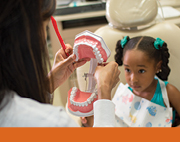Taking Care of Your Young Patients
 February is National Children’s Dental Health Month. According to the U.S. Centers for Disease Control and Prevention, tooth decay is one of the most infectious diseases among children and teenagers, and you can make a difference. As general dentists, you are the gatekeepers to oral health, and understanding current pediatric treatment methods is critical.
February is National Children’s Dental Health Month. According to the U.S. Centers for Disease Control and Prevention, tooth decay is one of the most infectious diseases among children and teenagers, and you can make a difference. As general dentists, you are the gatekeepers to oral health, and understanding current pediatric treatment methods is critical.The September 2017 AGD Impact cover story addresses strategies for treating children in your practice, including a list of 10 steps toward successful pediatric dentistry appointments (see below). “Making a Big Difference with Little Patients” provides tips and techniques to accommodate the needs of young patients in your practice. Read the full article.
10 Steps Toward Successful Pediatric Dentistry Appointments
Being positive, friendly and accommodating will only get you so far with a child. You’ll also need strategies to manage stressed, uncooperative or difficult young clientele. Try these recommendations, provided by the American Academy of Pediatric Dentistry and interviewed general dentists:
- Make the first visit a nontreatment visit. “The most successful way to gain trust is to have the parent bring the child to my office when the parent needs to have their teeth cleaned and let them watch, take a ride in the chair and meet the staff,” says Jack Ringer, DDS. “That way, they feel secure, safe and happy, so when it is their turn to come in, there is already a level of trust established.”
- Tell the child precisely what is needed to be cooperative and employ self-disclosing techniques of assertiveness. Use clear statements such as, “Please open your mouth wide so I can see your teeth.”
- Apply the “tell-show-do” method. Verbally explain treatment in words appropriate for the patient’s age, as well as demonstrate the visual, auditory, olfactory and tactile components of the procedure in a nonthreatening environment, and then complete the procedure.
- Alter the volume, tone or pace of your voice to influence and direct the child’s behavior.
- Use positive reinforcement to reward desirable behavior via verbal praise, positive voice modulation, appropriate physical expressions of affection and toys/prizes.
- Distract the child’s attention using technology (videos, handheld electronics) and brief breaks during a stressful appointment.
- Don’t practice pediatric dentistry solo. “Always have at least two adults, preferably a dental assistant, in the room with you so there’s no chance of accusations or misrepresentations,” AGD member Roger P. Levin, DDS, founder and CEO of Levin Group Inc., advises.
- Consider parents in the operatory carefully. The presence of a parent near the child receiving treatment can either calm them or make them more anxious, depending on the patient.
- Consider administering nitrous oxide/oxygen inhalation as a safe and effective means of diminishing fear and improving communication.
- Communicate carefully with parents/caregivers.
- Convey oral home hygiene and dietary recommendations to the child and parent. “Stress the importance of daily tooth brushing and the proper amount of fluoride tailored to the individual child’s caries risk,” Gajanan Kulkarni, BDS, LLB, MSc, DDS, DipPaed, PhD, FRCD(C), associate professor, University of Toronto Faculty of Dentistry, says. “Model and demonstrate to parents how to properly brush and floss their children’s teeth at home. And provide dietary counseling on what snacks, foods and drinks are OK and are not OK.”
- Don’t assign blame for the child’s oral health issues. “Gently educate parents on new types of habits they should adopt without judging the parents on their previous behavior,” Anna Jotkowitz, BDSc, a faculty member at Harvard School of Dental Medicine, says.
- Try to make the parent(s) feel as comfortable as possible “Remember — if the parent is relaxed, the child is going to be relaxed, and vice versa,” Kulkarni says.
